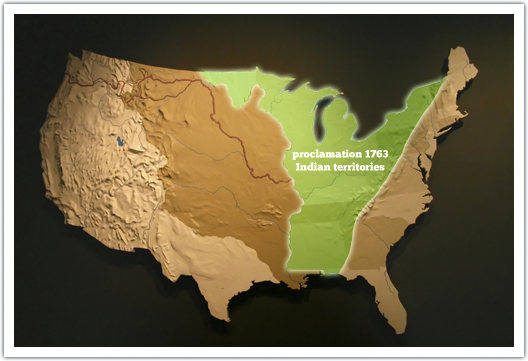Portrait of King George III by Allan Ramsay, hangs in the National Portrait Gallery in London, England

King George III of England, also know as
the Mad King due to a period of erratic behavior that resulted from
an illness, was quite in his legal rights when he summarily
disenfranchised colonial land syndicates with his Proclamation of
1763 following the 'French and Indian War.'
King George declared that all Indians in
the Americas, or 'discovered lands' of North America, were entitled
to occupy their aboriginal homelands without molestations from the
colonists. The Appalachian watershed was established as a
dividing line between the British settlements and colonies, and
lands deemed by the king to be Indian County.
People who had settled on land not
ceded to Britain by the Indians themselves were thereby ordered to
remove themselves from Indian land. The King rightly arguled
that only he had the authority to negotiate with Indian tribes for
cessions of land, as one sovereign to another sovereign.
Members of the colonian land syndicates, men such as George
Washington and Benjamin Franklin, rebelled against the royal
perogative and argued that they should be allowed to negotiate with
the Indians directly, but their arguments were dismissed as having
no basis in International law.
The real powers at work here were the
businessmen in London who feared that moving the frontier beyond
the mountains would break the colonists dependency on London
merchants for trade, and in this, the merchants were correct.
That is exactly what happened when the colonists won
independence from the crown and began pushing west.
When the tables were turned in 1787,
and George Washington and Benjamin Franklin were now esteemed
members of the federal government, they changed their tune with
regard to Indian lands. Now, they argued the very same
principles put forward by King George III in 1763 by stating that
only the federal government had the right to deal with Indian
tribes for land cessions, as one sovereign to another. By
this time, American settlers were already ignoring both the king's
proclamation, and the U.S. Constitution's Commerce Clause, and were
setting up towns in treaty protected Indian lands on the Ohio River
betwen Pittsburn and the river's mouth.
The turbulent and tragic history of
Euro-American settlers on the Indian frontier began, in many
respects, when King George III ordered colonists removed from
Indian lands. History, that timeless midwife of irony, would
soon see the grandchildren of those colonists removing Indians from
their own homelands during the Removal Era of the 19th century.
Related People
Related Events
Related Flashpoints